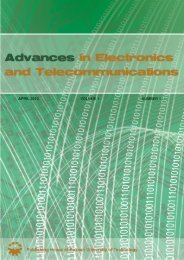november 2010 volume 1 number 2 - Advances in Electronics and ...
november 2010 volume 1 number 2 - Advances in Electronics and ...
november 2010 volume 1 number 2 - Advances in Electronics and ...
Create successful ePaper yourself
Turn your PDF publications into a flip-book with our unique Google optimized e-Paper software.
42 ADVANCES IN ELECTRONICS AND TELECOMMUNICATIONS, VOL. 1, NO. 2, NOVEMBER <strong>2010</strong><br />
Methods of Real-time Calculation of Allan<br />
Deviation <strong>and</strong> Time Deviation<br />
Andrzej Dobrogowski <strong>and</strong> Michał Kasznia<br />
Abstract—The methods enabl<strong>in</strong>g real-time calculation of two<br />
commonly used parameters of tim<strong>in</strong>g signals – Allan deviation<br />
(ADEV) <strong>and</strong> time deviation (TDEV) – are presented <strong>in</strong> this<br />
paper. The idea of real-time computation of both parameters<br />
is described. The results of experimental tests of the methods<br />
enabl<strong>in</strong>g separate as well as jo<strong>in</strong>t real-time ADEV <strong>and</strong> TDEV<br />
computation are presented <strong>and</strong> discussed.<br />
Index Terms—tim<strong>in</strong>g signal, time error, Allan deviation, time<br />
deviation<br />
I. INTRODUCTION<br />
THE Allan deviation ADEV <strong>and</strong> time deviation TDEV<br />
allow the type of phase noise affect<strong>in</strong>g the tim<strong>in</strong>g signal<br />
to be recognized. The parameters are commonly used for<br />
evaluation of signals generated by atomic clocks as well as<br />
for describ<strong>in</strong>g the quality of synchronization signal <strong>in</strong> the<br />
telecommunication networks [1]–[3]. The evaluation of the<br />
synchronizationsignal is commonlyatwo-stage process.First,<br />
the sequence of time error samples between the analyzed<br />
signal <strong>and</strong>somereferencehasto bemeasuredat somenetwork<br />
<strong>in</strong>terface. When the measurement is completed, the calculation<br />
of the parameter’s estimate us<strong>in</strong>g time error samples is<br />
performed. Such procedure causes an obvious delay <strong>in</strong> the<br />
evaluation process.<br />
This paper describes the real-time methods of ADEV <strong>and</strong><br />
TDEV computation, which enable the reduction of the evaluation<br />
time. These methods allow the estimates of ADEV<br />
<strong>and</strong> TDEV (which characterizes of more complex estimator’s<br />
formula) to be computed <strong>in</strong> the real time, dur<strong>in</strong>g the measurementprocess,simultaneouslyforaset<br />
ofobservation<strong>in</strong>tervals.<br />
Additionally,thecomputationprocesscanbeperformedjo<strong>in</strong>tly<br />
for both parameters.<br />
In order to calculate the ADEV <strong>and</strong> TDEV estimate simultaneously<br />
for several observation <strong>in</strong>tervals <strong>in</strong> the real<br />
time, all necessary operations should be performed <strong>in</strong> the<br />
time period between two sampl<strong>in</strong>g <strong>in</strong>stants, i.e. dur<strong>in</strong>g the<br />
sampl<strong>in</strong>g <strong>in</strong>terval τ0. The ability of perform<strong>in</strong>g the realtime<br />
assessment depends on several conditions: computation<br />
ability of the measurement equipment, sampl<strong>in</strong>g <strong>in</strong>terval <strong>and</strong><br />
<strong>number</strong> of the observation <strong>in</strong>tervals considered. The methods<br />
described <strong>in</strong> the paper are developed for a measur<strong>in</strong>g system<br />
A. Dobrogowski is with Chair of Telecommunication Systems <strong>and</strong> Optoelectronics,<br />
Poznan University of Technology, ul. Polanka 3, 60-965 Poznań,<br />
Pol<strong>and</strong> (e-mail: dobrog@et.put.poznan.pl).<br />
M. Kasznia is with Chair of Telecommunication Systems <strong>and</strong> Optoelectronics,<br />
Poznan University of Technology, ul. Polanka 3, 60-965 Poznań, Pol<strong>and</strong><br />
(e-mail: mkasznia@et.put.poznan.pl).<br />
This work was supported by the M<strong>in</strong>istry of Science <strong>and</strong> Higher Education<br />
<strong>in</strong> the frame of the project <strong>number</strong> N N517 1645 33 <strong>in</strong> the years 2007-<strong>2010</strong>.<br />
where the time error counter <strong>and</strong> the computer controll<strong>in</strong>g the<br />
measurement are two separate units. Therefore, the computer<br />
may be changed depend<strong>in</strong>g on the comput<strong>in</strong>g requirements.<br />
The results of experimental tests of the methods proposed<br />
for different conditions are presented <strong>in</strong> the paper. The calculations<br />
were performed for the time error sequences taken<br />
with sampl<strong>in</strong>g <strong>in</strong>terval τ0 = 1/30 s, which is often used<br />
<strong>in</strong> the telecommunication applications. Different <strong>number</strong>s <strong>and</strong><br />
lengths of observation <strong>in</strong>tervals simultaneously analyzed were<br />
considered.<br />
II. ALLAN DEVIATION AND TIME DEVIATION<br />
The computations of the Allan deviation <strong>and</strong> time deviation<br />
estimates are based on the averag<strong>in</strong>g of second differences of<br />
the phase process x(t) of the analyzed tim<strong>in</strong>g signal. We can<br />
assume for the telecommunication applications, <strong>in</strong> the case<br />
of negligible <strong>in</strong>fluence of frequency drift, that ADEV <strong>and</strong><br />
TDEVareestimatedbasedonthetimeerrorfunctionmeasured<br />
between the analyzed tim<strong>in</strong>g signal <strong>and</strong> the reference one [1]–<br />
[3].<br />
The formulae for the estimators of Allan deviation ADEV<br />
<strong>and</strong> the time deviation TDEV take the form:<br />
A ˆ �<br />
�<br />
�<br />
DEV (t)= � 1<br />
2n2τ 2 0 (N−2n)<br />
N−2n �<br />
(xi+2n − 2xi+n + xi) 2 (1)<br />
i=1<br />
T ˆ �<br />
�<br />
�<br />
� 1<br />
DEV(t)= �<br />
6n2 ⎡<br />
� �<br />
(N−3n+1)<br />
N−3n+1 j+n−1<br />
⎣ (xi+2n−2xi+n+xi)<br />
j=1<br />
(2)<br />
where {xi} is a sequence of N samples of time error function<br />
x(t) taken with <strong>in</strong>terval τ0; τ = nτ0 is an observation<strong>in</strong>terval.<br />
In order to simplify the computation process, the formula<br />
of the TDEV estimator (2) can be changed [4], [5]. After<br />
conversion the formula takes the form:<br />
i=j<br />
T ˆ �<br />
�<br />
�<br />
DEV (nτ0) = �1 1 1<br />
6 N − 3n + 1 n2 where<br />
N−3n+1 �<br />
j=1<br />
⎤<br />
⎦<br />
2<br />
S2 j (n), (3)<br />
Sj(n) = Sj−1(n)−xj−1+3xj+n−1−3xj+2n−1+xj+3n−1 (4)<br />
<strong>and</strong><br />
S1(n) =<br />
n�<br />
(xi+2n − 2xi+n + xi) (5)<br />
i=1<br />
When comput<strong>in</strong>g <strong>in</strong> the real time, we do not have access<br />
to the time error samples <strong>in</strong>dexed by i + n or i + 2n for







